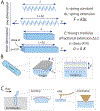Physical properties of the bacterial outer membrane
- PMID: 34732874
- PMCID: PMC8934262
- DOI: 10.1038/s41579-021-00638-0
Physical properties of the bacterial outer membrane
Abstract
It has long been appreciated that the Gram-negative outer membrane acts as a permeability barrier, but recent studies have uncovered a more expansive and versatile role for the outer membrane in cellular physiology and viability. Owing to recent developments in microfluidics and microscopy, the structural, rheological and mechanical properties of the outer membrane are becoming apparent across multiple scales. In this Review, we discuss experimental and computational studies that have revealed key molecular factors and interactions that give rise to the spatial organization, limited diffusivity and stress-bearing capacity of the outer membrane. These physical properties suggest broad connections between cellular structure and physiology, and we explore future prospects for further elucidation of the implications of outer membrane construction for cellular fitness and survival.
© 2021. Springer Nature Limited.
Figures




References
Publication types
MeSH terms
Substances
Grants and funding
LinkOut - more resources
Full Text Sources
Other Literature Sources

